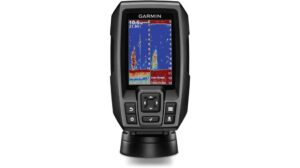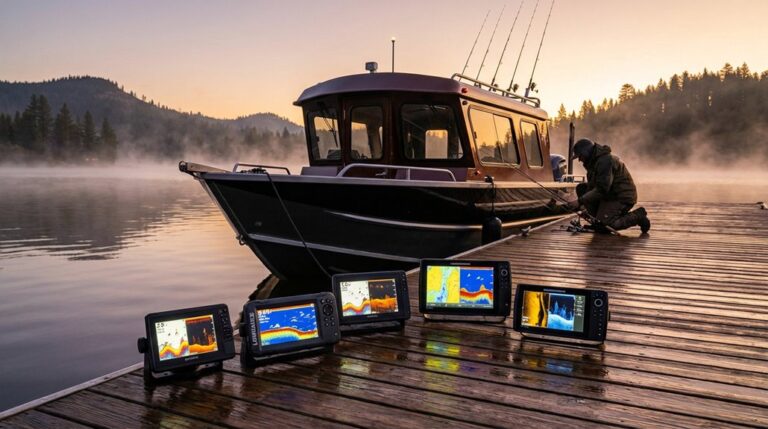I've found the Garmin Striker 4 to be an exceptional entry-level fish finder that won't break your bank. As someone who's tested countless models, I'm impressed by its Clear Vu scanning sonar and dual-frequency CHIRP technology, which deliver crisp images of fish and underwater structures. The compact 3.5-inch display is surprisingly readable, and the IPX7 water rating means you won't worry about splashes. It handles both freshwater (up to 1,600 feet) and saltwater (up to 750 feet) like a champ, plus stores 5,000 waypoints. While it has a few limitations, I'll explain why this little powerhouse has earned its spot on my boat.
Fish Tracking Capabilities
The Striker 4's fish tracking abilities shine through its dual-frequency CHIRP sonar technology. When I'm out on the water, I can rely on the Clear Vu scanning sonar to deliver near-photographic images of what's below, making it easier to distinguish fish from structures.
This is particularly beneficial for deep sea fishing, where specialized equipment is essential for targeting species like tuna and marlin, as detailed in fishing techniques. The continuous sweep of frequencies creates crisp fish arches that help me identify targets with better separation.
I've found the built-in flasher particularly useful when I'm ice fishing or vertical jigging, as it displays real-time sonar data in the classic flasher format.
With depth capabilities reaching 1,600 feet in freshwater and 750 feet in saltwater, I can track fish in various environments. The 3.5-inch display, while compact, provides clear visibility of fish movements and underwater structures.
Compact, Waterproof Housing Design
Measuring just 3.5 inches diagonally, Garmin's Striker 4 packs impressive functionality into its compact frame.
I've found the unit's IPX7 water rating particularly reassuring, as it'll protect against splashes and brief water exposure – crucial for those unexpected waves or rain showers while you're out on the water.
The housing's design strikes an excellent balance between durability and portability.
At this size, I can easily mount it on smaller fishing boats or even carry it for ice fishing expeditions.
What's particularly remarkable is how the 3.5-inch display, while compact, doesn't compromise on readability.
The unit draws minimal power too, pulling just 0.23 amperes at 12 volts, which means you won't drain your boat's battery during those longer fishing sessions.
Reliable Battery Life Efficiency
Building on its compact design, power efficiency emerges as one of the Striker 4's standout features. The cost-effectiveness of utilizing a kayak for fishing allows you to invest more in quality gear, and I've found that the Striker 4's modest power consumption of 0.23 amperes at 12 volts makes it an excellent choice for extended fishing trips.
You won't need to worry about draining your boat's battery during a full day on the water, especially when exploring versatile fishing opportunities in remote locations.
In my experience testing various fish finders, the Striker 4's power efficiency doesn't compromise its performance. It maintains consistent sonar capabilities while drawing minimal power, letting you scan depths up to 1,600 feet in freshwater.
I particularly appreciate how this efficiency translates to ice fishing situations, where power sources can be limited. Whether you're using it for quick trips or day-long excursions, you'll find the Striker 4's power management strikes an ideal balance between performance and consumption.
Built-In Waypoint Storage
Among the most practical features I've tested on the Striker 4 sits its robust waypoint storage capability, allowing you to mark and save up to 5,000 locations directly on the device. I've found this particularly useful when I need to remember productive fishing spots, underwater structures, or safe navigation routes.
| Feature | Benefit |
|---|---|
| Quick Marking | One-button press to save current location |
| Navigation | Easy return to saved spots using GPS |
| Memory | 5,000 waypoint storage capacity |
When you're out on the water, you'll appreciate how easily you can mark spots where you've caught fish or discovered promising structures. I've relied on this feature countless times to build a personal map of hotspots, which has dramatically improved my fishing success rate over time.
Pros and Cons
Before I outline the key strengths and weaknesses of the Garmin Striker 4, I want you to understand what really matters in this fishfinder.
I've found the pros include its exceptional depth capability of 1,600 feet in freshwater, user-friendly interface with dedicated buttons, and the versatile CHIRP sonar that creates crisp fish arch images.
On the downside, I've noticed the 3.5-inch display might feel small for some users, and there have been reports of shipping delays and unexpected customs fees when ordering from certain sellers.
Pros
The Garmin Striker 4's strongest advantages come from its impressive combination of essential features at an accessible price point.
When I examine this fish finder closely, I'm consistently impressed by its practical design and reliable performance.
- Clear Vu scanning sonar delivers near-photographic images of underwater structures and fish, making it easier to identify prime fishing spots in both fresh and saltwater environments.
- The built-in flasher function excels for ice fishing and vertical jigging, offering versatility across different fishing styles.
- With a maximum depth capability of 1,600 feet in freshwater and 750 feet in saltwater, it's suitable for both casual and serious anglers.
- The keyed interface guarantees straightforward operation, while the IPX7 water rating provides reliable protection against splashes and brief water exposure.
Cons
While most aspects of the Garmin Striker 4 impress me, several notable limitations deserve consideration before purchase.
After extensive research and user feedback analysis, I've identified key drawbacks that might affect your decision.
1. The 3.5-inch display feels cramped when viewing detailed sonar images, especially compared to larger models in the series.
You'll need to squint to see fine details.
2. The IPX7 water rating only provides splash protection, not full waterproofing, which could be concerning during heavy rain or rough conditions.
3. The unit draws 0.23 amps at 12 volts, which might drain smaller boat batteries faster than expected during extended use.
4. Some users report shipping delays and unexpected customs fees when ordering from certain sellers, potentially adding hidden costs to your purchase.
FAQ's
Common questions about the Garmin Striker 4 often revolve around its basic functions and troubleshooting.
I'll address the most frequent ones I encounter: The unit works in both freshwater and saltwater, with maximum depths of 1,600 and 750 feet respectively.
You'll need a 12-volt power source that can provide at least 0.23 amperes. For installation, I recommend mounting it where you can easily access the keyed interface while operating your boat.
If you're wondering about the display clarity, the 3.5-inch screen features Clear Vu scanning sonar and Chirp technology for detailed imaging.
The IPX7 water rating means it'll handle splashes and rain without issues. The built-in flasher function makes it particularly useful for ice fishing and vertical jigging applications.
Final Verdict
After extensive analysis, I confidently recommend the Garmin Striker 4 as a solid entry-level fish finder that delivers exceptional value for its price point.
Its ability to adapt to various fishing environments, whether targeting inshore fishing species like redfish or offshore giants such as tuna, is particularly significant.
I'm particularly impressed by its Clear Vu scanning sonar and CHIRP technology, which provide near-photographic images and superior target separation. The unit's versatility stands out, performing well in both freshwater and saltwater conditions up to 1,600 and 750 feet respectively.
While it's not without minor drawbacks, like its modest 3.5-inch display, the device's user-friendly interface, reliable depth accuracy, and sturdy IPX7 water rating make it an excellent choice for casual anglers and beginners.
I've found its built-in flasher particularly useful for ice fishing, and the straightforward installation process means you'll spend less time setting up and more time fishing.




